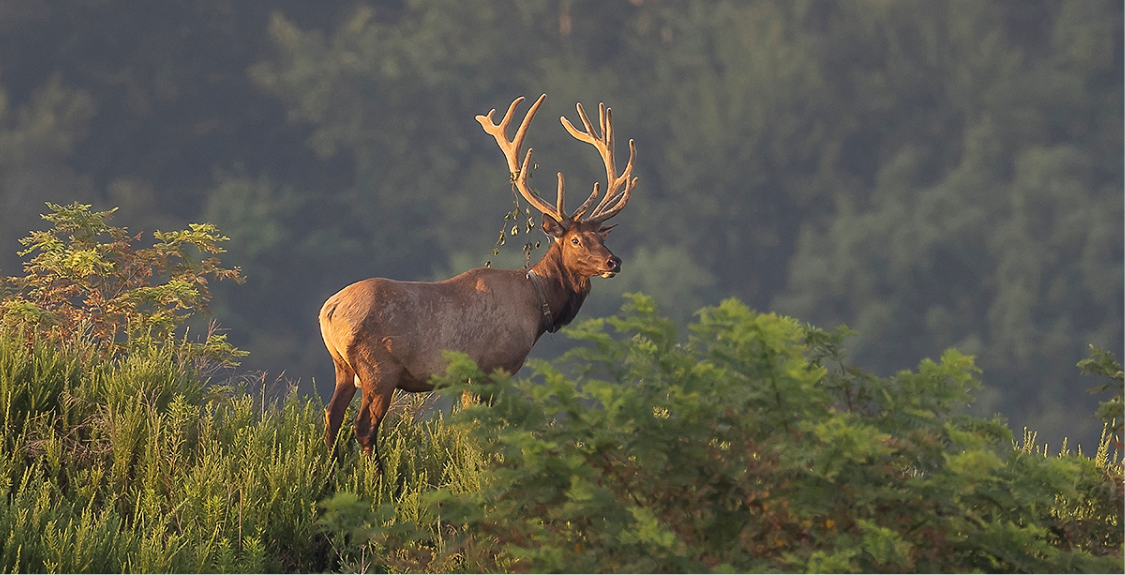AFM NEWS
Elk Are Home Again in West Virginia’s Wapiti Woods

The Comeback Story of Elk in West Virginia
Prior to European settlements, eastern elk were commonly found across the eastern United States, including West Virginia. Historical records indicate that elk were extirpated from the state around 1875. Almost a hundred years later, in 1972, the West Virginia Division of Natural Resources (WVDNR) developed a reintroduction feasibility study, which set off a chain of events that led us where we are today.
- 2005: In cooperation with the Rocky Mountain Elk Foundation, the WVDNR conducted additional feasibility studies.
- 2011: After the successful reintroduction of elk in the neighboring state of Kentucky and the subsequent immigration of Elk into West Virginia, an elk management plan was drafted.
- 2015: The West Virginia legislature passed legislation creating an official Elk Management Area and tasked the WVDNR with the development of an active elk restoration project.
- 2015: The Conservation Fund in late 2015, with the goal of assisting the state of West Virginia with its Elk restoration program, purchased approximately 32,000 acres from Heartwood Forestland Fund II in Logan and Mingo Counties, WV, and from Heartwood Forestland Fund III in Lincoln County, WV, and was the largest single land acquisition for wildlife management in state history. Scott Bosley, District Manager in Prosperity, WV, assisted with conveying the sale through AFM Real Estate. When The Conservation Fund purchased the property, they aptly named it the “Wapiti Woods Property.”
- 2016-today: The Conservation Fund sold approximately 16,000 acres to the state of WV, and this acreage became the Tomblin Wildlife Management Area. In addition, The Conservation Fund sold a conservation easement to the state of West Virginia on the remaining 16,229 acres, further helping the WVDNR with their elk restoration program.
Why This Land? Habitat, Protection, and the Return of the Elk
Elk require diverse habitats in the place they call home, from woodlands to open grassland. This makes the Wapiti Woods site perfect for their reintroduction, as it is composed of mountainous hardwood timberlands with several thousand acres of open grassland created from reclaimed surface coal mining that occurred from the late 1990s to roughly 2010.
AFM manages the 16,229 acres, retained by The Conservation Fund and subsequently sold in late 2023, for the current landowner, which is adjacent to the 16,000-acre state-owned property. The Tomblin and Laurel Lake Wildlife Management areas encompass the entire 16,229 acres. Our team frequently collaborates and interacts with the WVDNR and the new landowner to ensure the objectives of the easement are met.
The conservation easement plays an important role in ensuring that the land is maintained exclusively for wildlife habitat. Conservation easements are legally binding perpetuity, and this one has clear objectives, including:
- Conserve and manage the wildlife habitats, uplands, and open spaces for the management and enhancement of wild birds and mammals and their habitats, as well as providing public use and access to wildlife.
- Provide for the economically and ecologically sustainable production of fiber and other wood products and harvesting of forest resources in a manner compatible with maintaining water quality, fish and wildlife habitat, soil productivity, and recreational values.
- Provide the public with wildlife-oriented recreational opportunities, such as hiking, bird watching, hunting, trapping, and observation.
Once all the pieces were in place, WVDNR began reintroducing elk to the site. The elk have been brought in from several different locations, including the Land Between the Lakes National Recreation Area in Western Kentucky and from the state of Arizona. While the herd started with only 24 elk, there are now over 140, with the herd continuing to grow each year as elk calves are born. As the herd grows, so does the popularity and recreational potential of the site.
Experience Tomblin Today: Recreation, Wildlife, and What’s Next
There is no shortage of recreational opportunities at the Tomblin WMA. The 25,155 acres are open all year round, and offer camping, hunting, fishing, birding, wildlife tours, and more. Whether you’re fishing or hunting, you’ll need a license and adhere to all regulations. Big game includes deer, turkey, and bear; small game includes rabbits, grouse, doves, woodcocks, and squirrels; fish species include largemouth bass and trout. For those interested in viewing the majestic elk in all their glory, join a wildlife viewing tour in September or October and book an excursion through wvstateparks.com. In 2024, WV officials were planning a new viewing tower and visitors’ center to highlight the restoration program and provide the public with more opportunities to enjoy the success of this years-long venture.
The success of the Tomblin Wildlife Management Area is a powerful reminder of what’s possible when conservationists, communities, and state agencies unite behind a common goal. From a small herd of 24 elk to a thriving ecosystem and public treasure, Wapiti Woods is no longer just a name, but a promise kept.
